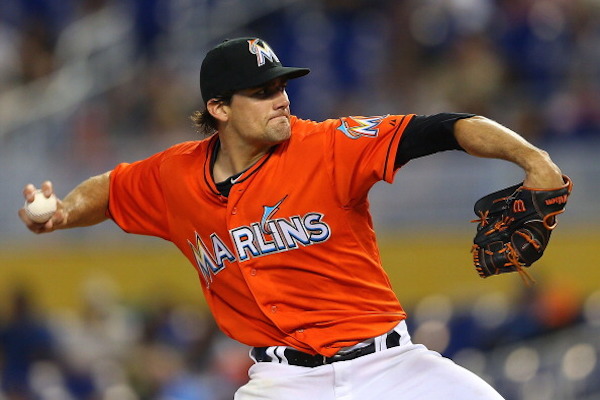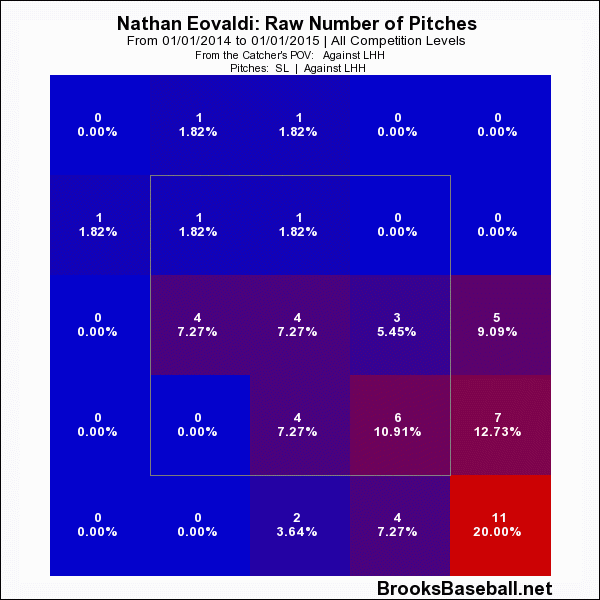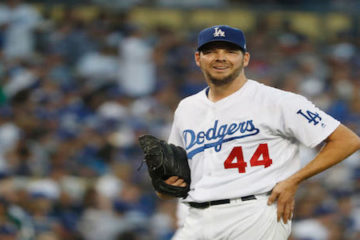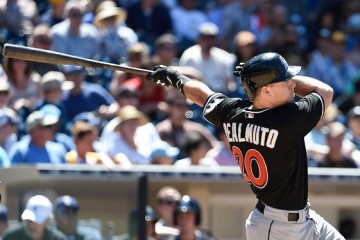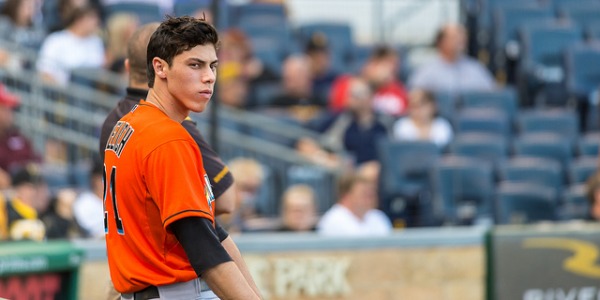2014 Fantasy Baseball: So, Nate Eovaldi?
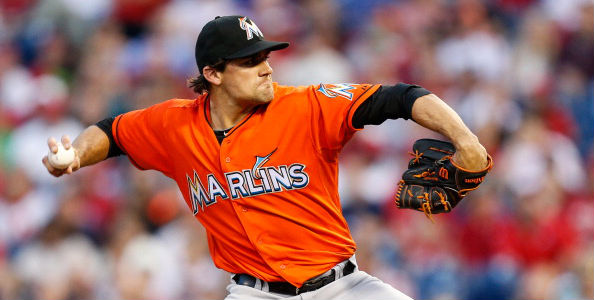
Nate Eovaldi has been somewhat of a contentious subject over the past few weeks. Or at least before the season began. There isn’t much to argue about now considering his results – 2.87 ERA & 2.10 FIP in a little over 31 innings.
Before the season, though, some writers felt that he was better suited for the bullpen, at least long term. Others felt he would be fine in the rotation over the long haul. Both sides could end up being right, I suppose? Although that wouldn’t be much fun. I don’t have a dog in the race, but so far I’ve been pretty damn impressed with Eovaldi’s performance.
[am4show have=’p3;p4;p7;p11;’ guest_error=’Front Office’ user_error=’Front Office’ ]
Eovaldi has always thrown hard. Very hard. Among starters with at least 100 innings pitched in 2013, no one threw harder, on average, than Eovaldi, who sat at 96.1 mph. However, outside of velocity, he’s never really had much of anything else. His slider was decent last year, but it was still a work in progress. And, as noted by Eno Sarris a few times, he doesn’t really have a change-up. At least one that’s any good. But despite all of that, he’s flourished so far this season. How?
First things first, his velocity is still there. After averaging roughly 96 mph last season, the pitch is in the same vicinity this season. Secondly, his pitch usage (pictured below) is a little different. Third, he’s been a strike throwing machine. According to Fangraphs’ pitchf/x numbers, Eovaldi has thrown a first pitch strike 69.5% of the time, a 10.5% increase from last season. Sixty percent of his pitches have been in the strike zone, according to pitchf/x, a ~7% increase. As a result of his approach and new pitch usage, his strikeout rate has risen, despite the fact that his swinging strike rate is essentially the same as it was last season.
| Pitch | 2013 Usage | 2014 Usage | SwStr |
|---|---|---|---|
| Fourseam | 70.5% | 65.7% | 10.4% |
| Slider | 18.8% | 24.1% | 14.2% |
| Curveball | 9.0% | 6.4% | 6.3% |
| Change-up | 1.7% | 2.8% | 14.3% |
Eovaldi’s repertoire might not be deep, but his main two offerings are very good. A few weeks ago, the aforementioned Eno Sarris did some work on pitches’ and their individual benchmarks. To clarify, we know, thanks to the league stats page at Fangraphs, that that swinging strike rate for all pitches thrown last season was 9.3%. But that give us any idea what we should classify as a good swinging strike rate one a curveball. Luckily, thanks to Eno, we’re covered. On fourseam fastballs, a 6.9% rate is league average. For sliders, it’s 15.2%. Eovaldi is right around league average both, so not great, but not terrible either. However, when we look at the benchmarks for groundballs, Eovaldi’s numbers are a little more impressive.
| Benchmark GB Rate | Eovladi Rate ’13 | Eovaldi Rate ’14 | |
|---|---|---|---|
| Fourseam | 37.9% | 42.3% | 50.0% |
| Slider | 43.9% | 44.5% | 58.3% |
| Curve | 48.7% | 66.7% | 100.0% |
Eovaldi has been a groundball machine all season. His slider, on the other hand, has been a boon to his overall groundball rate, which currently sits at 56.5%; 10.8%% better than league average.
Fangraphs’ Jeff Sullivan, whom I hate for beating me to the punch this week, wrote a tremendous piece about Eovaldi’s approach this season. I found the following extremely interesting*:
Or any hard-throwing pitcher’s fastball with any strike-throwing pitcher’s approach. I almost cited Cliff Lee, but Lee’s on a level of his own. Nevertheless, let’s consider some Eovaldi rankings. At this writing, there are 114 qualified pitchers in the majors.
First-pitch strike rate: Eighth
Zone rate: First
Contact rate: 104th
Better than seven out of every 10 pitches have been strikes. More than a quarter of Eovaldi’s pitches have been thrown in 0-and-2, in 1-and-2 or in 2-and-2 counts. It would be almost blasphemous to suggest Eovaldi has Lee’s command — and he doesn’t have Lee’s command — but he’s running a Lee-esque strike rate and walk rate with a far livelier arm. Eovaldi isn’t pitching like a guy with his arm is supposed to pitch.
If Eovaldi’s zone rate were to hold up, it would be the highest qualified zone rate in the whole PITCHf/x era, by nearly two percentage points. In Eovaldi’s past three starts, he’s posted three of his four highest career zone rates. He’s attacking, almost without mercy, and one notices he has 23 strikeouts and two unintentional walks. He’s like Henderson Alvarez, plus an adjustment.
I wrote briefly about Eovaldi’s improvement about being in the zone more, but Jeff puts his improvement into a better frame of reference. He goes on to explain that despite Eovaldi’s high contact rate, he’s limiting damage because a ton of the contact off of his pitches are foul balls instead of balls actually in play.
How does a pitcher strike out 22% of batters with one of the league’s highest contact rates? Interestingly, Eovaldi leads baseball in foul-ball rate. Foul balls aren’t the same as swings and misses, but they also aren’t the same as balls in play. They basically are swings and misses until you have two strikes. Presuming the foul rate regresses, the question will be in which direction. Will that poor contact turn into good contact or no contact? The answer will determine the likely direction of Eovaldi’s strikeout rate, but as long as he’s throwing this many strikes, the strikeouts will never disappear completely.
Getting ahead in the count is vital, because batters fare significantly worse when they’re behind in the count. Eovaldi’s limited repertoire hasn’t gotten him into trouble in part because he’s been able to get ahead in the count, and because he’s been able to bury back-foot sliders to left handed batters. Sliders have the largest platoon split for any pitch, on average. So, it stands to reason, that left handed batters shouldn’t struggle a great deal with Eovaldi’s slider, but they have so far because of his ability to locate it.
He’s been burying the slider down and in to lefties. Missing and leaving the pitch over the middle will get him, or any pitcher, hurt from time to time, but on average you aren’t getting hurt that far down and in.
Eovaldi may struggle at times if his command goes in and out, but he should be able to bail himself out more times than not due to his velocity and groundballing ways. He’s only a two pitch pitcher at this stage, but perhaps he can make it work. He’s made it work for the last 137 innings, so let’s see how much further he can take this. Technically you could sell high, and if someone offers you a ridiculous return you should probably take it, but don’t actively shop Eovaldi. If you had the foresight to draft him, simply sit back and enjoy your spoils.
*Note: some of the numbers in block quotes taken from Sullivan’s piece might be a little off considering his piece was written before Eovaldi’s Wednesday start versus Atlanta
As always, thanks to Fangraphs, Baseball Reference, and Brooks Baseball for the data.
[/am4show]


